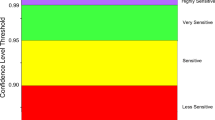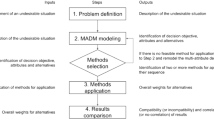Abstract
Nowadays, with the development of information management infrastructures in organizations and the improvement of the data storage process, managers are looking for appropriate decision-making methods based on large volumes of data. Therefore, it is crucial to choose the right approach to make the right decisions based on the volume of available data. The present study seeks to provide a comprehensive framework for the decision-making process using big data, even when it is incomplete. The framework of multiple criteria decision making (MCDM) consists of criteria and alternatives, whereas in real-world cases, decision-makers may face several criteria and alternatives. In this study, the Principal Component Analysis (PCA) approach was selected for the criteria clustering. Later, the K-means algorithm is used to cluster the alternatives, which estimates the optimal number of clusters using the Elbow method. The Fuzzy TOPSIS (TOPSIS-F) and Ordinal Priority Approach (OPA) have been used to rank clusters. Ultimately, the best alternative in the top cluster has been identified with the aid of the OPA, which has a unique function to solve MCDM problems with incomplete data. For evaluating the performance of the proposed approach, first, a pilot testing has been executed on a real-world case, and then a practical study was conducted at a refinery equipment manufacturing company with a project-oriented organizational structure. The approach is flexible, interactive, intelligent, and integrative, and significantly reduces the time and computation costs for the decision-makers. The results confirmed the soundness of the proposed approach, which can be used by managers of different companies with confidence.










Similar content being viewed by others
References
Ait-Mlouk A, Agouti T (2019) DM-MCDA: a web-based platform for data mining and multiple criteria decision analysis: a case study on road accident. SoftwareX 10:100323
Ataei Y, Mahmoudi A, Feylizadeh MR, Li DF (2020) Ordinal priority approach (OPA) in multiple attribute decision-making. Appl Soft Compu J 86:105893
Bao F (2020) “Best_kmeans(X).” MATLAB central file exchange. https://www.mathworks.com/matlabcentral/fileexchange/49489-best_kmeans-x. Accessed 8 Sept 2020
Bumblauskas D, Gemmill D, Igou A, Anzengruber J (2017) Smart maintenance decision support systems (SMDSS) based on corporate big data analytics. Expert Syst Appl 90:303–317
Cerny BA, Kaiser HF (1977) A study of a measure of sampling adequacy for factor-analytic correlation matrices. Multivar Behav Res 12(1):43–47
Chen CT (2000) Extensions of the TOPSIS for group decision-making under fuzzy environment. Fuzzy Sets Syst 114(1):1–9
De Tré G, De Mol R, Bronselaer A (2018) Handling veracity in multi-criteria decision-making: a multi-dimensional approach. Inf Sci 460–461:541–554
Duan Y, Edwards JS, Dwivedi YK (2019) Artificial intelligence for decision making in the era of big data—evolution, challenges and research agenda. Int J Inf Manag 48:63–71
Holland SM (2008) Principal components analysis (PCA). University of Georgia, Athens
Hwang CL, Lai YJ, Liu TY (1993) A new approach for multiple objective decision making. Comput Oper Res 20(8):889–899
Ijadi Maghsoodi A, Kavian A, Khalilzadeh M, Brauers WK (2018) CLUS-MCDA: a novel framework based on cluster analysis and multiple criteria decision theory in a supplier selection problem. Comput Ind Eng 118:409–422
Javed SA, Liu S (2019) Bidirectional absolute GRA/GIA model for uncertain systems: application in project management. IEEE Access 7:60885–60896
Javed SA, Mahmoudi A, Liu S (2020) Grey absolute decision analysis (GADA) method for multiple criteria group decision making under uncertainty. Int J Fuzzy Syst 22:1073–1090
Jiménez A, Mateos A, Ríos-Insua S (2009) Missing consequences in multiattribute utility theory. Omega 37(2):395–410
Kaiser HF (1974) An index of factorial simplicity. Psychometrika 39(1):31–36
Kannan SR, Ramathilagam S, Chung PC (2012) Effective fuzzy C-means clustering algorithms for data clustering problems. Expert Syst Appl 39(7):6292–6300
Kashani AG, Graettinger AJ (2015) Cluster-based roof covering damage detection in ground-based lidar data. Autom Constr 58:19–27
Kauffmann E, Peral J, Gil D, Ferrández A, Sellers R, Mora H (2019) A framework for big data analytics in commercial social networks: a case study on sentiment analysis and fake review detection for marketing decision-making. Ind Mark Manag 90:523–537
Ketchen DJ, Shook CL (1996) The application of cluster analysis in strategic management research: an analysis and critique. Strategy Manag J 17(6):441–458
Kourtit K, Nijkamp P (2018) Big data dashboards as smart decision support tools for I-cities—an experiment on Stockholm. Land Use Policy 71:24–35
Kurilovas E (2018) On data-driven decision-making for quality education. Comput Hum Behav 107:105774
Lai Y-J, Liu T-Y, Hwang C-L (1994) TOPSIS for MODM. Eur J Oper Res 76(3):486–500
Lever J, Krzywinski M, Altman N (2017) Points of significance: principal component analysis. Nat Methods 14(7):641–642
Liou JJH, Chuang YC, Zavadskas EK, Tzeng GH (2019) Data-driven hybrid multiple attribute decision-making model for green supplier evaluation and performance improvement. J Clean Prod 241:118321
Lloyd SP (1982) Least squares quantization in PCM. IEEE Trans Inf Theory 28(2):129–137
Ma W, Xiong W, Luo X (2013) A model for decision making with missing, imprecise, and uncertain evaluations of multiple criteria. Int J Intell Syst 28(2):152–184
Mahmoudi A, Deng X, Javed SA, Zhang N (2020a) Sustainable supplier selection in megaprojects: grey ordinal priority approach. Bus Strategy Environ. https://doi.org/10.1002/bse.2623
Mahmoudi A, Javed SA, Mardani A (2020b) Gresilient supplier selection through fuzzy ordinal priority approach: decision-making in post-COVID era. Oper Manag Res (in press)
Mahmoudi A, Mi X, Liao H, Feylizadeh MR, Turskis Z (2020c) Grey best-worst method for multiple experts multiple criteria decision making under uncertainty. Informatica 31(2):331–357
Manly BFJ (2005) Multivariate statistical methods: a primer. Chapman & Hall/CRC Press, Boca Raton
Mardani A, Jusoh A, Zavadskas EK (2015) Fuzzy multiple criteria decision-making techniques and applications—two decades review from 1994 to 2014. Expert Syst Appl 42(8):4126–4148
Olander S, Landin A (2005) Evaluation of stakeholder influence in the implementation of construction projects. Int J Project Manag 23(4):321–328
Opricovic S, Tzeng G-H (2004) Compromise solution by MCDM methods: a comparative analysis of VIKOR and TOPSIS. Eur J Oper Res 156(2):445–455
Palczewski K, Sałabun W (2019) Influence of various normalization methods in PROMETHEE II: an empirical study on the selection of the airport location. Procedia computer science, vol 159. Elsevier B.V., Amsterdam, pp 2051–2060
Pedrycz W (1994) Why triangular membership functions? Fuzzy Sets Syst 64(1):21–30
Peng Y, Zhang Y, Kou G, Shi Y (2012) A multicriteria decision making approach for estimating the number of clusters in a data set. PLoS ONE 7(7):e41713
Peng DH, Peng B, Wang TD (2019) Reconfiguring IVHF-TOPSIS decision making method with parameterized reference solutions and a novel distance for corporate carbon performance evaluation. J Ambient Intell Humaniz Comput 11(9):3811–3832
Preetha R, Vinila Jinny S (2020) Early diagnose breast cancer with PCA-LDA based FER and neuro-fuzzy classification system. J Ambient Intell Humaniz Comput. https://doi.org/10.1007/s12652-020-02395-z
Ralambondrainy H (1995) A conceptual version of the K-means algorithm. Pattern Recogn Lett 16(11):1147–1157
Rencher AC, Christensen William F (2012) Methods of multivariate analysis, 3rd edn. Wiley, Hoboken
Ringnér M (2008) What is principal component analysis? Nat Biotechnol 26(3):303–304
Saaty TL (1990) How to make a decision: the analytic hierarchy process. Eur J Oper Res 48(1):9–26
Sattarpour T, Nazarpour D, Golshannavaz S, Siano P (2018) A multi-objective hybrid GA and TOPSIS approach for sizing and siting of DG and RTU in smart distribution grids. J Ambient Intell Humaniz Comput 9(1):105–122
Sharif Ullah AMM, Noor-E-Alam M (2018) Big data driven graphical information based fuzzy multi criteria decision making. Appl Soft Comput J 63:23–38
Sharma DK, Dhurandher SK, Agarwal D, Arora K (2019) KROp: k-means clustering based routing protocol for opportunistic networks. J Ambient Intell Humaniz Comput 10(4):1289–1306
Sidhu J, Singh S (2017) Design and comparative analysis of MCDM-based multi-dimensional trust evaluation schemes for determining trustworthiness of cloud service providers. J Grid Comput 15(2):197–218
Tang M, Liao H (2019) From conventional group decision making to large-scale group decision making: what are the challenges and how to meet them in big data era? A state-of-the-art survey. Omega. https://doi.org/10.1016/j.omega.2019.102141
Thorndike RL (1953) Who belongs in the family? Psychometrika 18(4):267–276
Witten IH, Frank E, Hall MA, Pal CJ (2011) Data mining: practical machine learning tools and techniques. The Morgan Kaufmann Series in Data Management Systems
Wold S, Esbensen K, Geladi P (1987) Principal component analysis. Chemom Intell Lab Syst 2(1–3):37–52
Wu T, Liu XW (2016) An interval type-2 fuzzy clustering solution for large-scale multiple-criteria group decision-making problems. Knowl Based Syst 114:118–127
Yadegaridehkordi E, Hourmand M, Nilashi M, Shuib L, Ahani A, Ibrahim O (2018) Influence of big data adoption on manufacturing companies’ performance: an integrated DEMATEL-ANFIS approach. Technol Forecast Soc Change 137:199–210
Yasin Ali M, Sultana A, Khodadad Khan AFM (2016) Comparison of fuzzy multiplication operation on triangular fuzzy number. IOSR J Math 12(4):35–41
Zadeh LA (1965) Fuzzy sets. Inf Control 8(3):338–353
Acknowledgements
This study was supported by the National Natural Science Foundation of China under Grant No. NSFC-71771052. The work presented in this paper corresponds to the doctoral dissertation of the first author at the Southeast University, China. More information regarding the ordinal priority approach (OPA) can be found at www.ordinalpriorityapproach.com. The authors would like to thank Mr Mostafa Parvizi from FSK company for his support and cooperation.
Author information
Authors and Affiliations
Corresponding author
Additional information
Publisher's Note
Springer Nature remains neutral with regard to jurisdictional claims in published maps and institutional affiliations.
Rights and permissions
About this article
Cite this article
Mahmoudi, A., Deng, X., Javed, S.A. et al. Large-scale multiple criteria decision-making with missing values: project selection through TOPSIS-OPA. J Ambient Intell Human Comput 12, 9341–9362 (2021). https://doi.org/10.1007/s12652-020-02649-w
Received:
Accepted:
Published:
Issue Date:
DOI: https://doi.org/10.1007/s12652-020-02649-w




